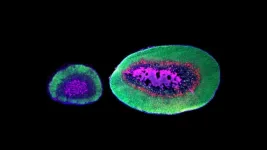(Press-News.org)
After the first Omicron wave, research shows that many of the risks of Covid infection changed
Before February 2022, always wearing face masks and being retired were associated with reduced risk, but not after
Overseas travel was not associated with increased risk prior to February 2022, but then became a significant risk
Peer reviewed – meta-regression- humans
New research from the University of East Anglia has found that wearing face masks did not lower the risk of Covid infection following the initial surge of the Omicron variant.
The analysis of official data found that several risk factors for infection altered significantly as the dominant variant in the UK changed from Delta to Omicron in December 2021.
These included wearing a mask, a history of foreign travel, household size, whether people were working or retired, and contact with children or over-70s.
Lead author Professor Paul Hunter, of Norwich Medical School at the University of East Anglia (UEA), said: “Early in the pandemic there were many studies published looking at risk factors for catching Covid, but far fewer studies after the first year or so.
“Our research shows that there were changes in some risk factors around the time that the Omicron BA.2 variant became dominant.”
Co-author Dr Julii Brainard, of UEA’s Norwich Medical School, said: “This isn’t totally surprising because laboratory evidence suggests that the Omicron variant was better able to infect the cells lining the upper respiratory tract than previous variants and so be more transmissible.
“Management of infection risk needs to be agile, adapting to epidemic development and better-quality information when it emerges.
“To prevent infections we need to have a good view of which factors might be most or least relevant. If those factors can change, we need to be alert to that happening.”
The researchers analysed data available from the Office for National Statistics (ONS) Covid survey in England, which compared infection rates with an ongoing household survey of the population to estimate how many people had infections.
From November 2021 to May 2022, the ONS also asked people questions about their circumstances and habits to see if those factors could be linked to risk of positivity.
Professor Hunter added: “We used this dataset to look for constancy or change in the importance and direction of potential risk factors for testing positive. We applied a statistical method called meta-regression to do this.”
The study found that changes to risk factors included:
In November 2021, always wearing face masks at work, school or in enclosed spaces was associated with reduced risk of being infected in both adults and children, but after the first Omicron wave it was not.
Living in a house with five or more people was a risk at the beginning but by the end of the study period people in larger households (four and above) had negligibly greater risk than people living in singleton households.
Early overseas travel was not associated with increased risk, but later on it was.
Working in health or social care or in contact with others, was often found to be important in the first year of the pandemic, but was not associated with overall higher or changing risk of infection in the study period.
Being of ethnic minority was strongly associated with increased risk in the first few months of the UK epidemic, but was associated with lower risk and no significant trend change during the study’s full monitoring period.
Being retired was associated with reduced risk compared to those in work overall, but any protective effect had disappeared by February 27, 2022, which coincided with the start of the second Omicron wave.
By the end of February 2022, it became apparent that there was a decrease in risk for adults living with children aged 16 or under.
People under 70 who lived with someone aged 70 or older initially had a lower likelihood of testing positive, but this protective effect diminished by about mid-February, 2022.
The researchers said the balance of evidence is that wearing face coverings reduces transmission of respiratory infections in community settings and did reduce transmission of Covid-19. The question, however, is by how much.
Systematic review of pre-pandemic evidence and analysis of original survey data during the Covid-19 pandemic both indicated that mask wearing could or did reduce transmission of SARS-CoV-2 by about 19pc.
But these conclusions were derived mainly from data prior to the emergence of Omicron variants.
This latest research found that prior to Omicron BA.2, never wearing a mask was associated with an increased risk of around 30pc in adults and 10pc in children.
But by the second Omicron wave (mid to late February 2022 onwards) there was no protective effect from mask wearing in adults and possibly an increased risk of infection in children.
Professor Paul Hunter commented: “It should not be a surprise that risk factors change during a pandemic due to a highly infectious disease with a short duration of immunity like Covid.
“So called SEIRS (Susceptible, Exposed, Infected, Recovered, Susceptible) models of epidemics predict that as such an infection becomes endemic risk factors that powered the epidemic in its early stages become less important and the rate at which people lose immunity become more important in driving infection rates.”
Dr Brainard added: “A lot of potential risk factors for catching Covid didn’t change during this period, and that’s important to know too.
“We offer some possible explanations for why the changes may have happened, but we would need more focused research to understand for sure why there were changes in some risk factors.”
The study was funded by the National Institute for Health and Care Research (NIHR) Health Protection Research Unit in Emergency Preparedness and Response at King’s College London in partnership with the UK Health Security Agency (UKHSA) and in collaboration with the University of East Anglia.
‘Changing risk factors for developing SARS-CoV-2 infection from Delta to Omicron’ is published in PLOS ONE.
END
Wearing face masks did not reduce risk of COVID infection after first Omicron wave, research shows
2024-05-15
ELSE PRESS RELEASES FROM THIS DATE:
SF State receives $14M from the Genentech Foundation to support underrepresented students in STEM
2024-05-15
SAN FRANCISCO – May 15, 2024 – San Francisco State University announced today that it received $14 million from the Genentech Foundation to support two University programs that are training the next generation of life sciences leaders. The new five-year grant is the latest in the Genentech Foundation’s transformational support for University programs, which has totaled more than $33 million during their long-lasting partnership. This partnership has impacted more than 700 students since 2008, and an additional 350 students are projected to be supported by the new funding.
The new funds will continue sponsoring San Francisco State’s Genentech ...
Penalties for dropping out of ecosystem services incentive programs should equal lost environmental benefits
2024-05-15
Payment for Ecosystem Services programs (PES) are important tools that governments around the world use to improve water quality, protect forests and wildlife habitat, and sequester carbon. Under these programs, landowners - usually farmers - are paid to use their land in ways that protect or restore the environment, such as replacing row crops with trees or grassy zones adjacent to waterways. Many PES program contracts last 5 to 20 years, but participant drop out rates have consistently risen over the years.
A recent study by University of Maryland economists showed that PES programs ...
Lithuanian researchers’ new development in solar cell technology – a promise of a significant advancement in the field
2024-05-15
Researchers from Kaunas University of Technology (KTU), Lithuania, who contributed to the development of record-breaking solar cells a few years ago, expanded their invention. The self-assembled monolayers can now be applied not only in inverted but also in regular structure perovskite solar cells.
Self-assembling molecules arrange themselves into a single-molecule-thick layer and in this case, they act as an electron-transporting layer in solar cells.
“The molecules that make up these monolayers, like a clever glue, ...
A simple internet with significant possibilities
2024-05-15
It’s one thing to dream up a quantum internet that could send hacker-proof information around the world via photons superimposed in different quantum states. It’s quite another to physically show it’s possible.
That’s exactly what Harvard physicists have done, using existing Boston-area telecommunication fiber, in a demonstration of the world’s longest fiber distance between two quantum memory nodes to date. Think of it as a simple, closed internet between point A and B, carrying a signal encoded not by classical ...
Unwrapping the origin story of the baobab
2024-05-15
The baobab (Adansonia) is a genus of trees with eight extant (in existence currently) species and a long history of humans marveling at them. For as much admiration the baobabs get, there is an equal amount of mystery surrounding their origin.
Genomic and ecological analyses recently done by a global research team led by Sino-Africa Joint Research Center, CAS (hosted by Wuhan Botanical Garden of the Chinese Academy of Sciences), suggest that Madagascar, is the origin from where all other baobab species hail. With a deeper understanding of the baobabs' genetics, researchers are hoping to uncover some clues on what ...
The origin and long-distance travels of upside down trees
2024-05-15
The iconic baobabs, also known as upside-down trees, or the tree of life, have much cultural significance, inspiring innumerable arts, folklore, and traditions. A research published in Nature, involving international collaboration between Wuhan Botanical Garden (China), Royal Botanic Gardens (Kew, UK), University of Antananarivo (Madagascar) and Queen Mary University of London (UK) reveal a remarkable example of species radiation in Madagascar followed by long distance dispersal to Africa and Australia. With speciation, an astonishing divergence of pollination mechanisms evolved, that exploit hawkmoths, bats and lemurs for ...
Some mice may owe their monogamy to a newly evolved type of cell
2024-05-15
NEW YORK, NY — What makes the oldfield mouse steadfastly monogamous throughout its life while its closest rodent relatives are promiscuous? The answer may be a previously unknown hormone-generating cell, according to a new study published online today in Nature from scientists at Columbia's Zuckerman Institute.
"The hormone from these cells was actually first discovered in humans many decades ago, but nobody really knew what it did," said Andrés Bendesky, MD, PhD, a principal investigator at Columbia's Zuckerman Institute. "We’ve discovered ...
Mortality in patients hospitalized for COVID-19 vs influenza in fall-winter 2023-2024
2024-05-15
About The Study: This study found that in fall-winter 2023-2024, the risk of death in patients hospitalized for COVID-19 was greater than the risk of death in patients hospitalized for seasonal influenza.
Corresponding Author: To contact the corresponding author, Ziyad Al-Aly, M.D., email ziyad.alaly@va.gov.
To access the embargoed study: Visit our For The Media website at this link https://media.jamanetwork.com/
(doi:10.1001/jama.2024.7395)
Editor’s Note: Please see the article for additional information, including other authors, author contributions and affiliations, conflict of interest and financial disclosures, and funding and support.
# # ...
First ‘warm-blooded’ dinosaurs may have emerged 180 million years ago
2024-05-15
The ability to regulate body temperature, a trait all mammals and birds have today, may have evolved among some dinosaurs early in the Jurassic period about 180 million years ago, suggests a new study led by UCL and University of Vigo researchers.
In the early 20th century, dinosaurs were considered slow-moving, “cold-blooded” animals like modern-day reptiles, relying on heat from the sun to regulate their temperature. Newer discoveries indicate some dinosaur types were likely capable of generating their own body heat but when this adaptation occurred is unknown.
The new study, published in the journal Current Biology, looked at ...
Next-generation sustainable electronics are doped with air
2024-05-15
Semiconductors are the foundation of all modern electronics. Now, researchers at Linköping University, Sweden, have developed a new method where organic semiconductors can become more conductive with the help of air as a dopant. The study, published in the journal Nature, is a significant step towards future cheap and sustainable organic semiconductors.
“We believe this method could significantly influence the way we dope organic semiconductors. All components are affordable, easily accessible, and potentially environmentally friendly, which is a prerequisite for future sustainable ...






